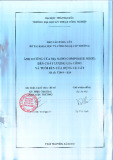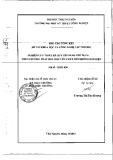
Note
α
S1
-Cn
D,
another
allele
associated
with
a
decreased
synthesis
rate
at
the
caprine
α
S1
-casein
locus
M.F. Mahé
F.
Grosclaude
Institut
National
de
la
Recherche
Agronomique,
Laboratoire
de
Génétique
Biochimique.
Centre
de
Jouy-en-Josas,
78350
Jouy-en-Josas,
France
(received
20
September
1988,
accepted
15
November
1988)
Summary —
A
seventh
allele
of
the
caprine
as
,--asein
locus,
called
!X
S1-Cn
D,
was
observed
in
French
Alpine
and
Saanen
breeds.
Its
frequency
in
a
large
herd
(AM 98)
was
0.025.
Like
!X
S1-Cn
B
-,
!X
S1-Cn
F
and
!X
S1-Cn
o,
this
allele
is
associated
with
a
decreased
synthesis
rate,
its
approximate
mean
contribution
being
0.6 -
0.8
g/I,
very
close
to
that of
!X
S1-Cn
F.
goat -
<X
s1
-caseln -
polymorphism -
quantitative
variations
Résumé —
<X
s1
-Cn
D,
un
autre
allèle
à
taux
de
synthèse
réduit
au
locus
de
la
caséine
o
si
-caprine.
Un
septième
allèle
du
locus
de
la
caséine
a
S1
-caprine,
as!!no,
a
été
observé
dans
les
races
Alpine
et
Saanen
françaises.
Sa
fréquence
dans
un
grand
troupeau
( N=198)
était
de
0,025.
Comme
a
S1
-Cn
B
-,
a
S1
-CnF
et
a
S1
-Cn
a,
cet
allèle
est
associé
à
un
taux
de
synthèse
réduit,
sa
contribution
moyenne
étant
d’environ
0,6
à
0,8
g4,
donc
très
proche
de
celle
d as!!nF.
chèvre -
caséine
as
, -
polymorphisme -
variations
quantitatives
Introduction
Grosclaude
et
al.
(1987)
have
recently
concluded
that
the
polymorphism
of
goat
cxs1
-casein
is
under
the
control
of
a
minimum
of
6
alleles.
Alleles
cx
S1-Cn
A,
cx
S1-Cn
B
and
cx
S1-Cn
c
were
found
to
be
associated
with
a
high
cx
s1-casein
content
(approximate
mean
contribution of
each
allele
being
3.6
g/1)
compared
to
cx
S1-Cn
F
and
a
si
-Cn"
which
are
associated
respectively
with
a
low
content
(0.6
g/1)
and
an
intermediate
content
(1.6
g/I),
while
cx
S1-Cn
o
appeared
to
be
a
true
null
allele.
In
the
same
publication,
the
authors
mentioned
the
presence
in
the
electrophoregrams
of
some
milks,
of
an
additional
band,
called
x,
which
reacted
in
immunoblotting
with
anti-a
s1
-casein
antibodies.
We
show
in
the
present
note
that
this
band
corresponds
in
fact
to
a
seventh
allele
of
the
cx
s1-casein
locus.

Material
and
Methods
Individual
milk
samples
were
obtained
from
the
&dquo;Station
de
Testage
Caprin&dquo;
near
Mois-
sac,
Sainte-Croix
Vall6e
Frangaise,
France
or
from
private
farms
located
in
west
central
France.
All
techniques
were
as
described
in
Grosclaude
etal.
(1987).
Results
and
Discussion
Band
x
(Fig.
2
in
Grosclaude
et
al.,
1987),
hereafter
called
D,
migrates
slightly
more
slowly
than
(3-casein
(Fig.
1)
in
SDS-polyacrylamide
gel.
Because
of
unavoidable
varia-
tions
in
the
electrophoretic
conditions,
this
band
may
be
masked
by
the
(i-casein
band,
but,
in
all
cases,
its
presence
can
be
ascertained
by
immunoblotting.
In
order
to
establish
the
genetic
determinism
of
fraction
D,
our
family
data
were
screened
for
the
presence
of
sires
transmitting
this
fraction
to
their
daughters.
One
such
sire,
numbered
A316,
was
found,
with
a
total
of
16
dam-daughter
pairs.
In
the
progeny
of
this
sire,
fraction
D
appeared
to
be
controlled
by
an
allele
of
the locus
a
si
-Cn
because
it
was
transmitted
in
atternance
with variant
F,
the
proportion
of
the
2
classes
of
daughters
not
being
significantly
different
from
the
1:
1 ratio
(Table
I).
In
addition,
12
dams
possessed
fraction
D,
together
with
either
variant
F
(9
cases)
or
variant
B-
(3
cases).
Except
in
one
dam-daughter
pair,
suspected
to
be
a
case
of
incor-
rect
parentage,
these
family
data
were
also
in
accordance
with
the
hypothesis
that
frac-
tion
D
is
controlled
by
an
allele
of
locus
a
si
-Cn.
Among
their
20
other
daughters,
issued

from
sires
which
did
not
transmit
fraction
D,
8
did
and
12
did
not
receive
D,
a
proportion
which
again
was
not
significantly
different
from
the
1:
1 ratio.
Grosclaude
et
al.
(1987)
reported
that,
curiously,
fraction
x
(here
D),
present
in
the
milk
of
certain
dams,
was
not
transmitted
to
their
daughters,
an
observation
at
variance
with
the
conclusions
of
the
present
note.
Re-examination
of
the
surviving
dam-daughter
pairs
among
the
7
considered
by
these
authors
suggests
the
probable
occurrence
of
2
parentage
errors
in
this
sample.
The
non-transmission
of
fraction
D
in
the
5
remaining
pairs
is
attributable
to
mere
chance
(P=
0.03).
Allele
a
S1
-Cn
D
is
the
seventh
allele
identified
at
the
goat
as!!asein
locus.
Its
frequency
in
the
large
Alpine
herd
of
Moissac
(N
=
198)
was
0.025.
It
was
also
observed
in
the
Saanen
breed.
Grosclaude
et al.
(1987)
estimated
that
the
frequencies
of
as
,-Cn
O
were
0.05
in
Alpine
and
0.03
in
Saanen.
Because
in
their
data
a
S1
-Cn
D
was
not
distin-
guished
from
as
,-Cn
O,
these
values
in
fact
apply
to
the
combined
frequencies
of
a
S1
-Cn
o
and
a
S1
-Cn
D.
The
frequencies
of
each
of
these
2
alleles
are
thus
rather
low
in
both
breeds.
On
immunoblots,
as
well
as
on
SDS-polyacrylamide
gels,
variant
as
,-CnD
appears
much
weaker
than
variants
a
S1
-CnA,
B
or
C.
Quantification
of
this
variant
by
rocket-
immunoelectrophoresis,
carried
out
on
individual
milk
samples
from
four
animals
with
the
genotype
as!-Cn!iF,
indicated
that
the
approximate
mean
contribution
of
allele
as
,-Cn
D
was =
0.6 -
0.8
g/I,
a
low
value,
close
to
that
found
for
a
S1
-Cn
F
(0.6
g/I).
Allele
a
si
-Cn
D
is
thus
the
fourth
out
of
a
total
of
7
alleles
associated
with
a
decreased
synthesis
rate
at
the
goat
ag
i
-casein
locus.
The
biochemical
particularities
of
variant
a
S1
-CnD
are
under
investigation.

Acknowledgments
We
thank
J. Bouillon,
A.
Maingot,
A.
Piacere,
G.
Ricordeau
and
J.-P.
Sigwald
for their
constant
and
valuable
help
and
N.
Mazure
for
her
skillful
assistance.
Reference
Grosclaude
F.,
Mah6
M.-F.,
Brignon
G.,
Di
Stasio
L.
&
Jeunet
R.
(1987)
A
Mendelian
polymorphism
underlying
quantitative
variations
of
goat
a
sr
-casein.
Génét.
Sél.
EvoL
19,
399-412
2


























